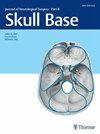Skull base repair following resection of vestibular schwannoma: a systematic review (Part 1: The Retrosigmoid Approach)
IF 0.9
4区 医学
Q3 Medicine
引用次数: 0
Abstract
Objective: Despite advances in skull-base reconstruction techniques, CSF leaks remain a common complication following retrosigmoid (RS) vestibular schwannoma (VS) surgery. We aimed to review and classify the available strategies used to prevent CSF leaks following RS VS surgery. Methods: A systematic review, including studies of adults undergoing RS VS surgery since 2000, was conducted. Repair protocols were synthesised into a narrative summary, and a taxonomic classification of techniques and materials was produced. Additionally, the advantages, disadvantages, and associated CSF leak rates of different repair protocols were described. Results: All 42 studies were case series, of which 34 were retrospective, and eight were prospective. Repair strategies included heterogeneous combinations of autografts, xenografts, and synthetic materials. A repair taxonomy was produced considering seven distinct stages to CSF leak prevention, including intraoperative approaches to the dura, internal auditory canal (IAC), air cells, RS bony defect, extra-cranial soft tissue, post-operative dressings, and CSF diversion. Notably, there was significant heterogeneity among institutions, particularly in the dural and IAC stages. The median postoperative incidence of CSF leaks was 6.3% (IQR 1.3%-8.44%). Conclusions: The intra-operative strategies used to prevent CSF leaks during RS VS surgery vary significantly between and within institutions. As a result of this heterogeneity and inconsistent reporting of CSF leak predictive factors, a meaningful comparative analysis of repair protocols was not feasible. Instead, we propose the development of a prospective multi-centre service evaluation designed to accurately capture a comprehensive dataset of potential CSF risk factors, including all stages of the operative repair protocol.前庭裂形瘤切除术后的颅底修复:系统性综述(第 1 部分:后脑勺方法)
目的:尽管颅底重建技术有所进步,但脑脊液泄漏仍然是乙状窦后(RS)前庭神经鞘瘤(VS)手术后的常见并发症。我们的目的是回顾和分类用于防止RS VS手术后脑脊液泄漏的可用策略。方法:系统回顾,包括2000年以来接受RS VS手术的成人研究。修复方案被综合成一个叙述性的总结,并产生了技术和材料的分类分类。此外,还描述了不同修复方案的优点、缺点和相关的脑脊液泄漏率。结果:42项研究均为病例系列,其中34项为回顾性研究,8项为前瞻性研究。修复策略包括自体移植物、异种移植物和合成材料的异质组合。考虑到脑脊液泄漏预防的七个不同阶段,包括术中硬脑膜入路、内耳道(IAC)、空气细胞、RS骨缺损、颅外软组织、术后敷料和脑脊液分流,形成了一种修复分类。值得注意的是,各机构之间存在显著的异质性,特别是在硬脑膜和IAC阶段。术后中位脑脊液漏发生率为6.3% (IQR为1.3% ~ 8.44%)。结论:术中预防RS VS手术中脑脊液泄漏的策略在不同机构和不同机构之间存在显著差异。由于这种异质性和脑脊液泄漏预测因素的不一致报道,对修复方案进行有意义的比较分析是不可实现的。相反,我们建议开发一种前瞻性的多中心服务评估,旨在准确捕获潜在CSF风险因素的综合数据集,包括手术修复方案的所有阶段。
本文章由计算机程序翻译,如有差异,请以英文原文为准。
求助全文
约1分钟内获得全文
求助全文
来源期刊

Journal of Neurological Surgery Part B: Skull Base
CLINICAL NEUROLOGY-SURGERY
CiteScore
2.20
自引率
0.00%
发文量
516
期刊介绍:
The Journal of Neurological Surgery Part B: Skull Base (JNLS B) is a major publication from the world''s leading publisher in neurosurgery. JNLS B currently serves as the official organ of several national and international neurosurgery and skull base societies.
JNLS B is a peer-reviewed journal publishing original research, review articles, and technical notes covering all aspects of neurological surgery. The focus of JNLS B includes microsurgery as well as the latest minimally invasive techniques, such as stereotactic-guided surgery, endoscopy, and endovascular procedures. JNLS B is devoted to the techniques and procedures of skull base surgery.
 求助内容:
求助内容: 应助结果提醒方式:
应助结果提醒方式:


